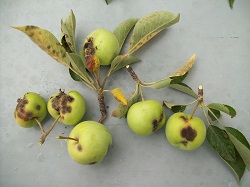ManageSafe™
Least-Toxic Control of Apple and Pear Scab Choose a different pests

|
Identification
Pest type: Fungi
In-depth information:
Apple and pear scab, while two different diseases (caused by two different fungi), look almost exactly the same and can be controlled with similar measures. Both diseases create spotting and scabbing on fruits, usually during the wet springtime.
The fungus Venturia inaequalis causes apple scab. It most commonly occurs severely in areas where spring and summer are cool and moist. However, it can be a problem wherever apples grow when weather conditions are similar. Apple scab also is a problem on ornamental crabapple. Pear scab, which the fungus V. pirina causes, creates blemishes on pear fruit, effectively killing the fruit. The disease is most prevalent in the North Coast production area. Apple scab cannot affect pears, and vice versa.
Both of these funguses that cause scab can survive winters through infected leaves on the ground, but rainfall or other water sources are necessary for spore release. In the springtime, air currents and splashing water help these spores move from infected leaves to new flowers, leaves or fruit, where the scab can reoccur.
Is it a problem?
Scab can destroy an apple or pear crop. The flowers and fruit can drop off when infected, or the fruit can become malformed and covered in unsightly scabs, making it unusable. In a small backyard crop, some late-season infections can be tolerated because the fruit can be peeled, removing smaller scabs.
Pest prevention practices
Remove potential habitat
Foster natural resilience
In-depth information:
Apple scab management focuses on prevention, rather than ‘curing’ an infected tree in midseason. Spores overwinter on infected leaves beneath the trees, and infect new leaves, flowers, and fruit the following spring. To prevent an outbreak each spring, rake leaves each fall and destroy by burning or composting. Avoid wetting foliage with sprinklers or other irrigation systems. If you are considering replacing or planting new trees, there are several varieties of apple trees being developed that are resistant to scab, including Liberty, Prima, and Priscilla.
Monitoring and record-keeping
You can first notice scab by the yellowing spots on the leaves. As scab gets worse, darker, olive colored spots will form on the leaves and fruit – sometimes even stems. There may be a velvet coating on the underside of some leaves due to fungal growth, and some affected leaves may twist or close in on themselves. Whole leaves may turn yellow and drop off.
If the scab begins to affect the flower stems, the petals may drop. Scabs may appear on the fruit in late season, beginning as greyish lesions with a red ring around them – the lesions may look like velvet or soot. Eventually these lesions can sink into the fruit and become tan-colored. Harsh infections may cause distortion of the fruit and eventual drop-off.
Non-chemical and mechanical controls
Remove debris and habitat
In-depth information:
According to UC IPM:
For a single, backyard tree, removing—then composting or destroying—its dropped leaves in autumn or winter can limit the disease to tolerable levels. In plantings of several trees, additional steps might be necessary to effectively control this disease, especially in cool, moist coastal areas. These include applying zinc and fertilizer-grade urea (or some other nitrogen source) to leaves in autumn to hasten leaf fall and adding lime to leaf piles beneath the tree. In pears, apply urea by itself, because zinc can be phytotoxic.
If you are using sprinklers that wet any of the tree’s foliage, irrigate between sunrise and noon to allow adequate drying time, or reduce the angle of the sprinkler.
Disease-resistant Cultivars
Table 1 lists the relative susceptibility of different apple varieties to apple scab. Major breeding efforts for disease resistance are ongoing in New York, where Enterprise, Liberty, Prima, Priscilla, and many newer varieties appear to be resistant to scab. Scab-resistant crabapples also are available.
Biological controls
Biological controls are not an effective means of controlling the apple and pear scab around your home.
Least-toxic chemical options as a last resort
According to UC IPM:
Several fungicides are available for controlling apple and pear scab. These include fixed copper, Bordeaux mixtures, copper soaps (copper octanoate), sulfur, and mineral or neem oils. All these products are considered organically acceptable.
Generally copper or Bordeaux sprays should be used only from green tip to full bloom. Later applications increase the risk of fruit russetting, a chemical burning of the fruit skin, although in some years this occurs even if you’ve used these materials only before full bloom. Fixed copper products include Lilly Miller Kop-R-Spray concentrate and Monterey Liqui-Cop. Bordeaux mixture is a combination of copper sulfate and hydrated lime that must be mixed just before application.
You can apply wettable sulfur through bloom and early fruit set. When using sulfur-containing compounds such as wettable sulfur, never apply them within 3 weeks of an oil application or when temperatures are near or higher than 90°F. Bordeaux has a narrower application time frame than other sulfur-containing products, because it contains copper, and shouldn’t be applied after full bloom.
Social Media
See what other folks are saying about this, and let us know what works for you.
Click the post above to view and comment on Facebook, or comment directly on this site below.








